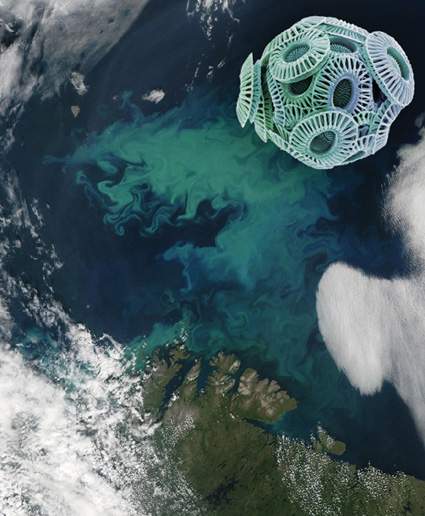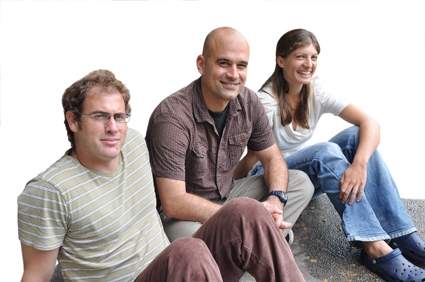Phytoplankton – plant-like single-celled organisms that float in water – are vital to the health of the planet, according to Dr. Assaf Vardi, who recently joined the Institute’s Plant Sciences Department. “We can thank phytoplankton for every second breath we take. Even though they make up just 0.5% of Earth’s biomass, phytoplankton rival the planets’ rainforests when it comes to absorbing carbon dioxide and releasing oxygen _ they carry out about half the photosynthesis on the planet.” And these microorganisms, whose name means “plant drifters” in Greek, are the base of the marine food chain: Without phytoplankton, there would be no life in the ocean. On the other hand, for reasons that aren’t completely understood, their reproduction sometimes gets out of hand, producing algal blooms that can extend hundreds and thousands of kilometers. Some of these blooms simply choke off waterways, while others, among them the infamous “red tides,” produce neurotoxins that kill fish and work their way up the food chain, where they can be toxic to livestock and humans worldwide.
Agricultural and sewage runoff, as well as and other forms of pollution, are currently increasing the severity of harmful algal blooms in lakes and near coastal waters. Moreover, climate change is likely to increase ocean temperatures and reduce the mixing between layers that now helps dispel harmful algal blooms. In research that takes him from the lab bench to the open ocean, Vardi is attempting to unravel the complex ecology of these organisms by investigating their genes and the signals they produce to cope with their ever-changing environment, especially those involving algal blooms. In recent research in fjords along Norway’s coastline, he was even able to induce algal blooms in a controlled setting, using specialized facilities there to investigate the process. His research subjects include diatoms, whose glassy shells sport an endless variety of intricate shapes, and coccolithophores, whose calcium carbonate-based shells make them active participants in the global carbon cycle.
A Meeting of Science and Art After earning a Ph.D. in molecular ecology from the Hebrew University of Jerusalem in 2004, Dr. Assaf Vardi conducted postdoctoral research at the Ěcole Normale Supĕrieure, Paris, and Rutgers University. He joined the Weizmann Institute faculty in 2010, and he has also been appointed an adjunct scientist at Woods Hole Oceanographic Institution. Vardi is married to the artist Nivi Alroy, who borrows concepts from Vardi’s scientific research on apoptosis and cell-cell communication and reinterprets them in her sculptures. The couple recently collaborated on a children’s book that explains ecology through the lives of microorganisms in a drop of water from the ocean. |
In his postdoctoral research, Vardi found that viruses are responsible for the disappearance of the algal blooms. But when he and his colleagues looked closely at the genetic sequences of both phytoplankton and virus, they found some surprises that led them to formulate new theories about their ecology and evolution. For instance, they discovered evidence for apoptosis – cell suicide – in the microorganisms. Apoptosis is ubiquitous in multi-celled organisms: Damaged or used-up cells die so that the whole may live. So why would a single-celled microorganism commit suicide? One explanation, says Vardi, is that the genes for cell death might have coevolved in both host and virus to prevent the virus from infecting and killing off all the phytoplankton – an evolutionary dead end. On the other hand, viruses may be recruiting the host cells’ death machinery to bud out after completing their replication cycle inside the cell. This could explain why the viruses seem to have genes previously seen only in host organisms.
It’s possible the phytoplankton have evolved a coordinated response to viral infection on the population level. A number of microorganisms are known to engage in such sophisticated group action, in which their communication is managed through chemical signals. Vardi is now searching for such signals in phytoplankton, which he has dubbed “infochemicals.” He has been finding that several of the substances he has identified in the lab – some produced by the phytoplankton, others by the viruses – appear at specific stages in the infection process. These could be used by researchers as biomarkers, he says, to monitor the health of plankton populations and catch viral infection in action in the oceans. Other types of infochemical might be directed toward competing species of marine microorganism. Vardi thinks that the fish-killing toxins produced in the algal blooms may even be a type of infochemical: “Phytoplankton may use them as a means of communication and for stress surveillance to help them acclimate to various environmental conditions.”
Understanding exactly what drives the ecological balance could be crucial to finding the means to restore it. But there could be side benefits to this research, as well. Infochemicals that induce apoptosis, for instance, might lead to new treatments for cancer and novel anti-viral drugs. And such genomes as those of the hard-shelled phytoplankton Vardi studies might yield useful information for nanomaterials scientists wanting to know the secrets of their minute and elaborate shell designs, or for scientists developing algae-based biofuels wanting to know which genes might increase their oil production.
Dr. Assaf Vardi's research is supported by the Raymond Burton Plant Genome Research Fund; the IPA Prize - for a promising New Scientist; Aboud and Amy Dweck, Rockville, MD; Charles Rothschild, Brazil; Roberto and Renata Ruhman, Brazil; and Luis Stuhlberger, Brazil. Dr. Vardi is the incumbent of the Edith and Nathan Goldenberg Career Development Chair.

